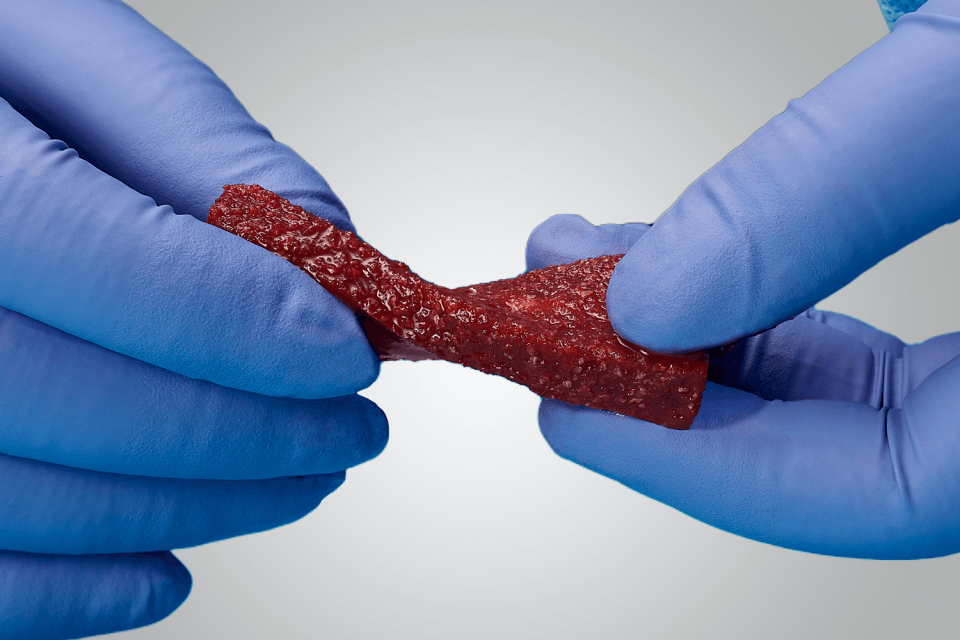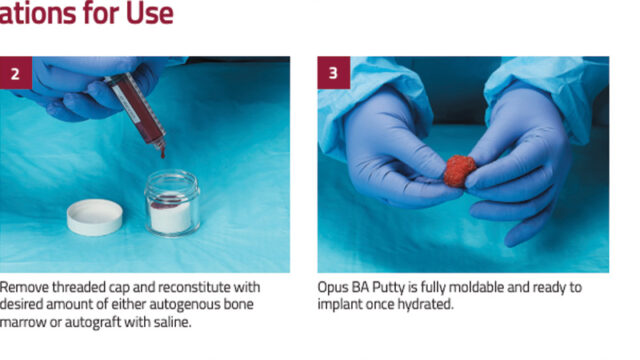
Opus BA
Osteoconductive Matrix
Opus™ BA is a synthetic bioactive solution that is easily hydrated and flexible. A carefully selected trifecta of components creates an ideal environment for bone growth building on the earlier generations of synthetic bone grafts.

Highlights
Carbonate Apatite Bone Mineral 50%
- Higher osteoclastic and osteoblastic activity than β-TCP & HA1
- Resorption & remodeling similar to human bone2,3
45S5 Bioactive Glass 30%
- Ideal particle range and size (100-300μm)4,5,6
- Ability to stimulate the growth and osteogenic differentiation of osteoblasts7
Type 1 Collagen 20%
- 100% resorbable8
- Binds proteins and cells and retains biological factors9
Support Material
Footnotes
- Kanayama, K., Sriarj, W., Shimokawa, H., Ohya, K., Doi, Y., Shibutani, T. 2011. Osteoclast and Osteblast Activities on Carbonate Apatite Plates in Cell Cultures. J. Biomaterials, 26, 435-436.
- Matsuura, A., Kubo, T., Doi K., Hayashi, K., Morita, K., Yokota, R., Hayashi, H., Hirata, I., Okazaki, M., Akagawa, Y. (2009). Bone formation ability of carbonate apatite-collagen scaffolds with different carbonate contents. Dental Materials Journal, 28(2), 234-242.
- Ellies, LG., Carter, J.M., Natiella, J.R., Featherstone, J.D.B., Nelson, D.G.A. (1988). Quantitative analysis of early in vivo tissue response to synthetic apatite implants. J. of Biomed. Mater. Res., 22, 137-148.
- Oonishi, H., Kushitani, S., Yasukawa, E., Iwaki, H., Hench, L.L., Wilson, J., Tsuji, E., Sugihara, T. (1997). Particulate Bioglass Compared With Hydroxyapatite as a Bone Graft Substitute. Clinical OrthoPaedics and Related Research, 334, 316-325, Lippincott-Raven Publishers, Philadelphia, PA.
- Schepers, E.J.G., Ducheyne, P. (1997). Bioactive glass particles of narrow size range for the treatment of oral bone defects: a 1-24 month experiment with several materials and particle sizes and size ranges. Journal of Oral Rehabilitation, 24, 171-181.
- Lindfors, N. C., Koski, I., Heikkilä, J. T., Mattila, K. and Aho, A. J. (2010), A prospective randomized 14‐year follow‐up study of bioactive glass and autogenous bone as bone graft substitutes in benign bone tumors. J. Biomed. Mater. Res., 94B, 157-164. doi:10.1002/jbm.b.31636
- Xynos, I.D., Hukkanen, M.V., Batten, J.J., Buttery, L.D.K, Hench, L.L., Polak, J.M. (2000). Bioglass 45S5 stimulates osteoblast turnover and enhances bone formation In vitro: Implications and applications for bone tissue engineering. Calcif Tissue Int. 67(4), 321-9.
- Li, S.T. (2000). Biomedical Engineering Handbook, In JD Bronzino (Eds.), Biologic Biomaterials: Tissue Derived Biomaterials (Collagen) (1st ed.) 2, 42, 1-23, CRC Press, Boca Raton, FL.
- Geiger, M., Li, R.H., Friess, W. (2003). Collagen sponges for bone regeneration with rhBMP-2. Science Direct / Elsevier, 55, 1613-1629. http://doi.org/10.1016/j.addr.2003.08.010

